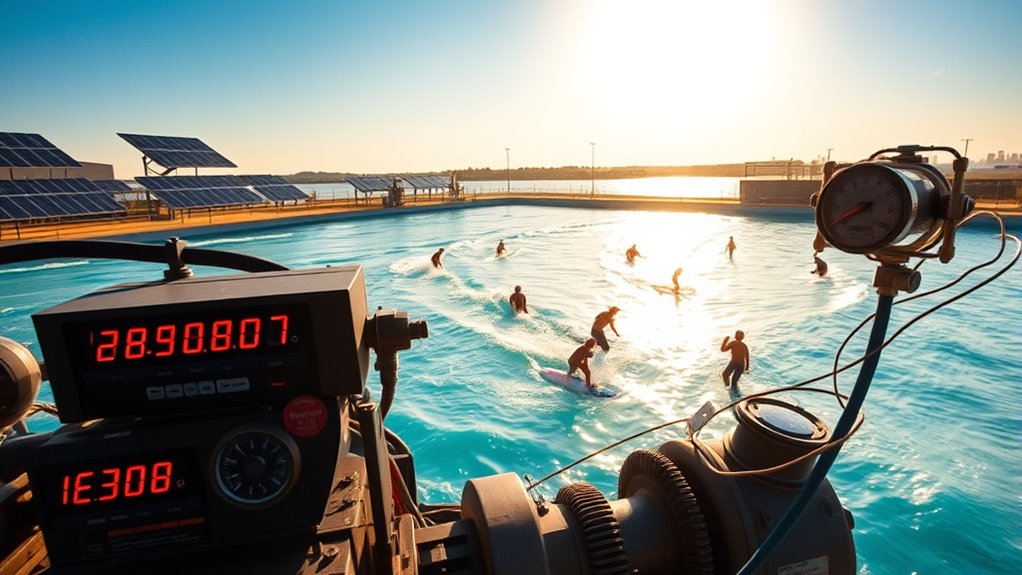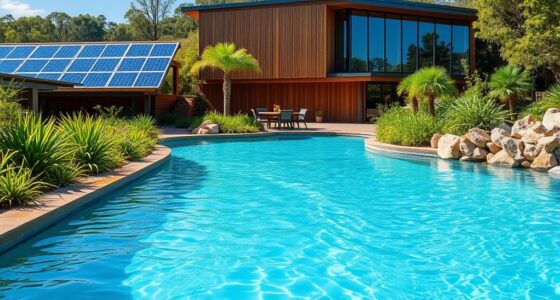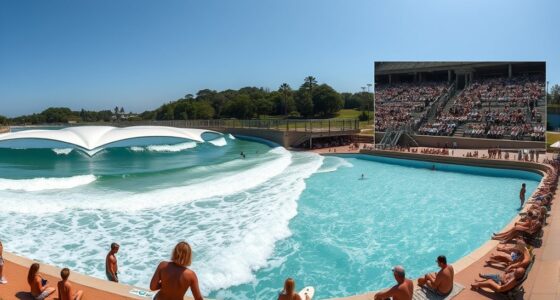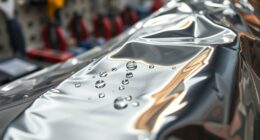Analyzing energy consumption in wave pool operations is vital for enhancing efficiency and sustainability. By properly managing wave energy and ensuring high pump efficiency, you can considerably reduce operational costs and the environmental footprint. Regular maintenance and advanced control systems can optimize pump performance while considering external factors like water temperature and pool size. These strategies not only preserve resources but also promote long-term savings. Discover more ways to implement effective energy practices for wave pools.
Key Takeaways
- Effective energy management in wave pools is crucial for reducing operational costs and environmental impact.
- Harnessing wave energy efficiently maximizes savings and operational performance in wave generation.
- High pump efficiency is essential to minimize energy waste and ensure cost-effective wave circulation.
- Regular maintenance and monitoring of pump performance help identify inefficiencies and enhance energy use.
- External factors like water temperature and pool size significantly influence overall energy consumption and efficiency strategies.
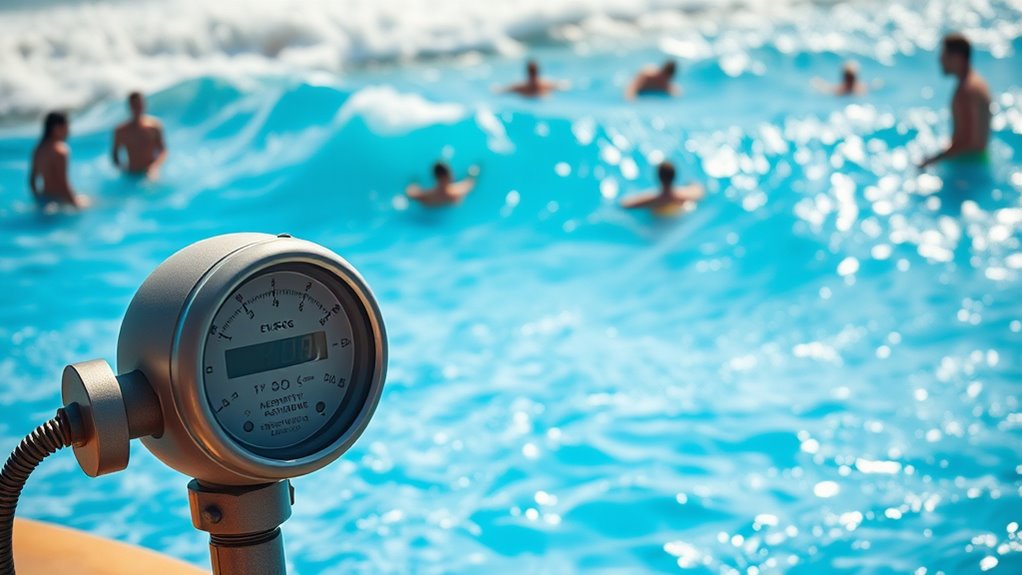
As you delve into the world of wave pool operations, you’ll quickly realize that energy consumption plays a critical role in their efficiency and sustainability. Managing this consumption effectively can considerably impact both operational costs and environmental footprints. One of the key components in this equation is wave energy—the force that generates those thrilling waves you see in the pool. Understanding how to harness this energy efficiently is essential for optimizing your operations.
Wave energy is an abundant resource, and when used correctly, it can lead to major savings. However, it’s not just about generating waves; it’s also about how effectively you convert that energy into usable power. This is where pump efficiency comes into play. The pumps used to circulate water and create waves must operate at peak efficiency to minimize energy waste. If your pumps aren’t performing well, you’ll find yourself consuming more energy than necessary, driving up costs and reducing the overall sustainability of your wave pool.
Effective wave energy conversion hinges on pump efficiency, crucial for minimizing energy waste and maximizing sustainability in wave pool operations.
To enhance pump efficiency, it’s imperative to select the right type of pump for your specific needs. High-efficiency pumps can considerably reduce energy consumption by optimizing the flow of water. Not only does this help in maintaining the desired wave patterns, but it also contributes to a more sustainable operation in the long run. Regular maintenance and monitoring of pump performance are equally important. Even minor inefficiencies can lead to increased energy expenditure, so keeping an eye on pump health can yield substantial benefits.
Additionally, integrating advanced control systems can further improve energy consumption. These systems can monitor wave conditions and adjust pump operations accordingly, ensuring that you’re only using the energy needed to produce the desired wave action. This dynamic approach allows for better management of wave energy, leading to a more responsive and sustainable operation.
Moreover, as you analyze energy consumption, consider the impact of external factors like water temperature and pool size. These elements can affect how much energy you need to maintain wave activity. By understanding their influence, you can make informed decisions that enhance overall efficiency. Embracing mindful decluttering strategies can also help in reducing unnecessary operational complexities, leading to a streamlined and efficient wave pool environment.
Frequently Asked Questions
What Types of Wave Pools Exist Worldwide?
There are several types of wave pools worldwide, each showcasing unique wave pool designs. Some create gentle surf for beginners, while others generate powerful waves for experienced surfers. You’ll find standalone wave pools in water parks, integrated systems within resorts, and even ocean-like experiences in aquatic entertainment venues. Each design serves different audiences, enhancing the overall enjoyment and thrill that wave pools bring to water enthusiasts everywhere.
How Do Wave Pools Differ From Traditional Swimming Pools?
Wave pools differ from traditional swimming pools mainly in their wave generation and water circulation systems. While traditional pools rely on still water, wave pools create artificial waves, allowing you to ride or surf. The water circulation in wave pools is designed to accommodate wave mechanics, ensuring a constant flow of water, which helps maintain the right conditions for riding. This dynamic environment offers a unique experience compared to the calm setting of a regular pool.
What Are the Environmental Impacts of Wave Pools?
Wave pools can have significant environmental impacts. They consume a lot of energy, especially when generating waves, which can strain local power resources. You can promote energy conservation by choosing facilities that prioritize renewable energy sources. Additionally, many wave pools implement water recycling systems, reducing water waste and minimizing their ecological footprint. By supporting these practices, you help mitigate the adverse effects and contribute to a more sustainable future for recreational water activities.
How Can Wave Pools Be Made More Sustainable?
You can make wave pools more sustainable by integrating renewable energy sources, like solar or wind power, to reduce reliance on fossil fuels. Implementing water recycling systems is another key step; it minimizes water waste and ensures that you’re using resources more efficiently. Additionally, consider optimizing the pool’s design to enhance energy efficiency. These strategies can considerably lower the environmental impact while still providing a fun experience for visitors.
What Innovations Are Emerging in Wave Pool Technology?
Innovations in wave pool technology are transforming the way you enjoy water attractions. You’ll find advancements in wave generation systems that create more realistic and diverse waves, enhancing your experience. Energy efficiency is also on the rise, with new designs and materials that minimize power consumption while maximizing performance. These improvements not only elevate your enjoyment but also promote sustainability, ensuring that the thrill of wave pools can be enjoyed for generations to come.
Conclusion
So, next time you’re catching waves in that state-of-the-art wave pool, just remember: it’s not just your epic wipeout that’s making a splash. Those giant machines guzzling energy might as well be sipping lattes on a sunny beach. While you’re having your fun, the planet’s secretly holding its breath, waiting for the tab to come due. Who knew riding artificial waves could come with such a hefty carbon footprint? Let’s hope the ocean doesn’t start charging us rent!

